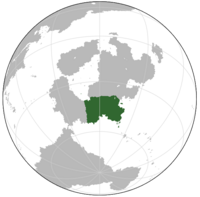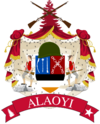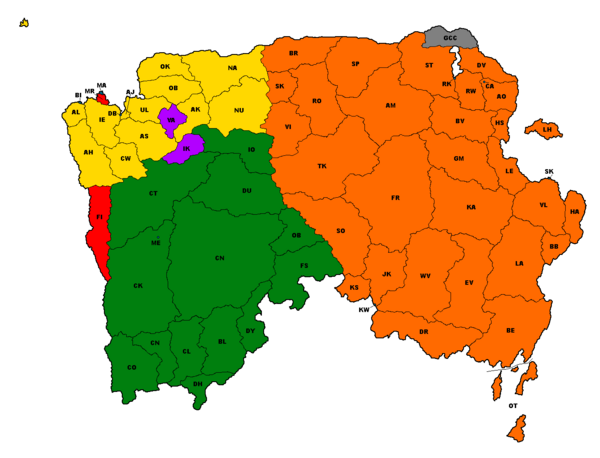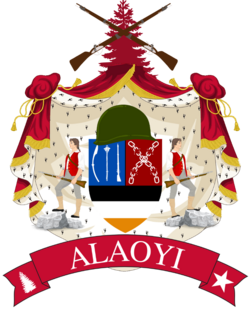Alaoyi
For the sake of brevity and neutrality all location names will be provided in the direct Fluvan translation
Federative Republic of Alaoyi 3 official names
| |||||||
|---|---|---|---|---|---|---|---|
| Anthem: National Song | |||||||
 | |||||||
| Capital | Seekant | ||||||
| Largest city | Biyonummiri | ||||||
| Official languages | Nuwelander Ndibeanyan | ||||||
| Recognised regional languages | Marchann Inith Naossian Vanhish Ikhetese | ||||||
| Ethnic groups (2022) |
| ||||||
| Religion (2020) |
| ||||||
| Demonym(s) | Alaoyian | ||||||
| Government | Federal presidential republic | ||||||
| Durand Francois | |||||||
| Tomás Ághas | |||||||
| Jens Hatenman | |||||||
| Miniwewe Jelani | |||||||
| Adaku Pierre | |||||||
| Legislature | Federal Parliament | ||||||
| National Council | |||||||
| Senate | |||||||
| Independence from the Alannan Kingdom | |||||||
• First Colonies | Summer 1799 | ||||||
| 11 January 1921 | |||||||
• Independence from Alanna | 15 June 1938 | ||||||
| 27 April 1987 | |||||||
| Area | |||||||
• Total | 3,585,588 km2 (1,384,403 sq mi) | ||||||
| Population | |||||||
• 2022 estimate | 177,000,000 | ||||||
• 2013 census | 176,180,862 | ||||||
• Density | 49.4/km2 (127.9/sq mi) | ||||||
| GDP (nominal) | 2022 estimate | ||||||
• Total | |||||||
• Per capita | |||||||
| Gini (2022) | medium | ||||||
| HDI (2022) | high | ||||||
| Currency | Alaoyian Mark (₥) (AMK) | ||||||
| Date format | yyyy-mm-dd | ||||||
| Driving side | right de jure mixed de facto | ||||||
| Calling code | +91 | ||||||
| ISO 3166 code | AL | ||||||
| Internet TLD | .al | ||||||
Alaoyi, officially the Federative Republic of Alaoyi (FRA), is the southernmost country in Galia. It is surrounded to the south and east by a vast coastline that stretches along the Achrinian Ocean, to the north by the neighbouring countries of Naossia and Dilania to the west by Inglaterra; and to the very northwest the Great Galian Sea. The country is mostly cold with terrain ranging from subpolar forests on the west coast to steppes in the east. With over 177 million people, Alaoyi is one of the largest countries on Manala. The capital is located in the city of Seekant, which lies along the eastern coastline. The largest city is Biyonummiri in the northwestern coast. Other major cities include Meirleach, Dimboru, Katwijk, Cathaisce, and Rivierkant.
About 80% of the population are "pales", most of whom belong to the Nuwelander and Diash groups. A signifigant Marchan population exists in the northwest with Inith populations existing to the west of the country. Other Cetanni groups inhabit the northeast of the country. The remaining population mostly consists of a large Ndibeanyan community, primarily centered along the northwest and central regions of the country. According to the 2020 census, the two most spoken first languages are Nuwelander (39%) and Ndibeanyan (21.8%). About 25% of Alaoyians speak Diash at home. Much of the population is, in addition to their native languages, somewhat fluent in Nuwelander, which commonly serves as a commerical and public language across the other language groups, a change from when Ndibeanyan was more common. Fluvan is also not uncommon.
The country first began as a set of colonial possessions belonging to Alanna at the midway point of the 18th century. After several wars of conquest Nuweland and the various Diash tribes fell under Alannan control by 1875. In 1921, the various possessions were unified under the control of viceroys, who served as governors of the various colonies. One viceroy would represent the various colonies in the imperial court. During the First Great War, the Alaoyian colonies fought alongside Alanna, mostly against the expanionist and newly independent Inglaterrans. However, tensions between the two led to war during the Third Great War on the Galian front. Just before the Second Great War, the Alaoyian colonies declared independence due to the revolution in Alanna. While some Alanna port cities were occupied, the majority of Alaoyian combat was against Inglaterra and alongside Antarctic and Niagaran troops. After the Second Great War ended, Alaoyi and Inglaterra fought a cold war and competed for regional power. After the Third Great War, Alaoyi became a much stronger regional power, but tensions began in the 2010s with Inglaterra once more.
Alaoyi, from 1951 to 1987, was governed under a complex set of rules and laws regarding race relations, known as ewezuga. Under ewezuga the colonial (and minority) Alannans, chiefly Ndibeanyans, governed the country and had a high standard of living comparable to a first world nation. However, the segregated pale groups were often mistreated and suffered from a high rate of poverty. The ewezuga system was abolished by President Manale Agabe in 1987 after a long and sometimes violent movement by the Liberation Party with free elections being held in 1989. Since 1989, all major groups have been represented in the government.
Alaoyi is generally considered a regional power, dominating most of southern Galia. It is considered a developing country but great strides have been made in quality of life, governmental transparency, and income. However, severe inequality, crime, and poverty remain widespred. Just under two thirds of the country is dry desert conditions, either hot or cold, or tundra. The remaining 36.5% is mostly a humid continental climate and almost two thirds of Alaoyi's population lives on just 36.5% of the land. In particular, the northwest of Alaoyi has nearly 22 million people in one of the most densely populated areas on Manala.
Eytomology
History
Prehistoric
Nuwelander Expansion
Ndibeanyan Exploration
Nuweland Wars
First Great War
Postwar and Independence
Second Great War
The Pale Unrest
Ewezuga
Third Great War and the End of Ewezuga
Geography
Topograhy
Climate
Demographics
Ethnicity
Religion
Education
Health
Urbanization
Politics
Alaoyi is a federal, presidential, representative democratic republic. Federal legislative power is vested in the Alaoyian Federal Parliament consisting of the Senate and the National Council, which together form the legislative body. The Senate is elected through direct elections using the mixed-member proportional representation system. The members of the National Council represents the federal entities of Alaoyi, with each receiving four delegates. The Alaoyian political system operates under a framework laid out in the 1987 constitution. Amendments generally require a two-thirds majority of both the Senate and the National Council; the fundamental principles of the constitution, as expressed in the articles guaranteeing human dignity, the separation of powers, the federal structure, and the rule of law, are valid in perpetuity.
The president, currently Durand Francois, is the head of state and government. He is elected by the people through a two round system. The second-highest official in the Alaoyian order of precedence is the chief minister, who is appointed by the president and responsible for the civil service, chairs meetings of the cabinet in the president's absence, and is the successor to the president in the event of his death. The third-highest official and the chair of the Senate is the Speaker, who is elected by the Senate by the party or coalition with the most seats in the Senate. Nominally equal to the Senate Speaker in precedent is the First Councilor, who is elected by the National Council to chair the National Council. As opposed to the overtly partisan role of the Senate Speaker, the First Councilor is a much more collegial position primarily focused on maintaining the schedule of the National Council rather than worrying about party discipline.
Since 2008, the party system has been dominated by the Socialist Party, Democratic Alliance, and National Populist Party. So far every President has been a member of one of these parties and one of these parties was the major partner in any governing coalition. Since 2003, the democratic socialist Republican Alliance has been a staple in the Senate, though they have never been able to be a dominant partner in a coalition. The centrist Farmer's Alliance, initially formed to represent rural voters in the interior, often plays an outsized role in Alaoyian politics due to
Federal Entities
Main article: Federal Entities of Alaoyi
Alaoyi is an asymmetric federation of 68 federal entities, divided into 29 provinces, 14 counties, 12 districts, 8 federal cities, 2 autonomous republics, 2 autonomous communities, and 1 national commonwealth. Most federal entities are considered identical in terms of representation on the National Council, but differ in their levels of autonomy.
| Federal Entities | Governance |
|---|---|
29 Provinces
|
The most common type of federal subject with a governor and locally elected legislature. Provinces tend to cover majority-Nuwelander areas. |
14 Counties
|
For all intents and purposes, counties are identical to provinces but in Diash-speaking areas. The title of "county" is historic, referring to the Diash royalty (counts) that ruled the area before being conquered by Alanna. |
12 Districts
|
For all intents and purposes, districts are identical to provinces and counties but in Ndibeanyan-speaking areas. The title of "district" comes from the subdivisions of Imperial Alanna and came over to what is now Alaoyi with the colonists. |
| Major cities that function as separate regions. | |
| Autonomous areas consisting of an ethnic minority, there are currently two; the Free State of Inithia and Marchan Democratic Republic. Both are considered to be legally independent nations, with their own government and legislature, that are represented by the Alaoyian government in international affairs, allow freedom of movement and commerce with Alaoyi, and are members of a currency union with Alaoyi. | |
| The only autonomous communities are the Ikhetese and Vanhish. Autonomous communities are technically parts of a districts but are given special rights and privileges that cannot be revoked by the district government. They are similar to autonomous republics, but have directorial council governments and are not legally independent. Autonomous communities are technically not granted representation on the national council, but one member of their district's delegation is appointed by the community government. | |
| National commonwealths are technically full fledged federal entities on par with a province or province-equivalent, but not considered to be legally independent like an autonomous republic is. National commonwealths consist of a nationally-recognized minority group and are generally autonomous. There is only one national commonwealth, the Greater Cetanni Commonwealth. |
Law
Alaoyian law is based on the civil law legal system and civil law concepts prevail over common law practice. Virtually all of Alaoyian law is codified.Court decisions set out interpretive guidelines; however, they are seldom binding on other specific cases. Doctrinal works and the works of academic jurists have strong influence in law creation and in law cases. Judges and other judicial officials are appointed after passing entry exams.
The legal system is based on the Alaoyian Constitution, promulgated on 27 April 1987, which is the fundamental law of Alaoyi. All other legislation and court decisions must conform to its rules. Federal entities have their own constitutions, which must not contradict the Federal Constitution. Legislative entities are the main source of statutes, although in certain matters judiciary and executive bodies may enact legal norms. Jurisdiction is administered by the judiciary entities, although in rare situations the Constitution allows the Senate to pass on legal judgments. There are also specialized military, labor, and electoral courts. The highest court is the High Tribunal.
Foreign Relations
Alaoyi has a strong network of diplomatic missions abroad and maintains relations with most major countries. Alaoyi is a founding member of the Global Assembly of Nations, the International Bank, and the GMF. Alaoyi in particular maintains a strong alliance with Los Angeles and the Antarctic Circle States and is founding member of the Galian Entente. Alaoyi is also close with the Furbish Islands and Gagium.
Military
The Alaoyian Armed Forces are composed of four branches – the Army the Navy, the Air Force, and the Federal Constabulary. The military is subordinate to the Ministry of National Defence of the Federative Republic of Alaoyi. However, its commander-in-chief in peacetime is the president, who nominates officers, the Minister for National Defence and the chief of staff. As of 2022, the Alaoyian Armed Forces have a combined strength of 500,000 active soldiers, with 91,000 being in the Constabularly.
Alaoyi is spending 3% of its GDP on defence, equivalent to approximately ₭39.6 billion in 2022, with a slated increase to ₭42.1 billion in 2024. From 2022 to 2024, Alaoyi is set to spend ₭110 billion on the modernisation of its armed forces, in close cooperation with Furbish, Niagaran, and local Alaoyian defence manufacturers. Also, the Alaoyian military is set to increase its size to 600,000 enlisted and officers.
Compulsory military service for men, who previously had to serve for nine months, was discontinued in 2001 but returned in 2015 following the Inglaterran invasion of Sekken and the subsequent buildup of Inglaterran forces on the Alaoyian border. However, less than 20% of men aged 18-27 will be conscripted, as the Alaoyian military has filled out its volunteer quotas every year since 2009.



